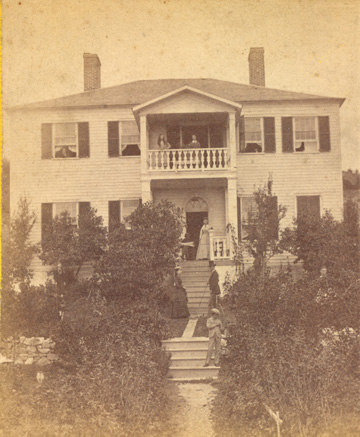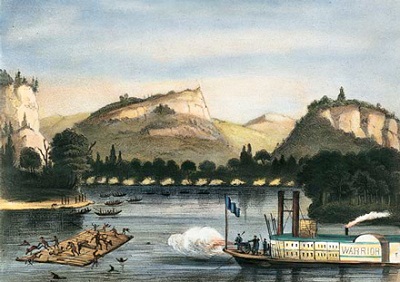As Indian Removal became the law of the land, tribal groups had few choices of how to navigate this. They could comply and either be sent off to reservations out of the way of white expansionism or try to assimilate into white society as best they could, or could defy the ruling and continue to fight for territory. The reactions among tribal people covered all ends of this spectrum.
Like the tribes that had reestablished themselves in the West following removal, the Native peoples remaining in the Great Lakes region by no means became powerless victims of federal policy upon their confinement to reservations.
Assimilating with the Whites

Mackinac State Historic Parks
In Michigan and Indiana, “hiding in plain view” became an effective means of avoiding removal during a period of American settlement leading to state formation. In many cases, Potawatomi and Miami Indians selected from within their communities mixed-race spokespersons with European names who not only mirrored so-called “civilized” behaviors, but also looked white. By representing themselves as whites, these tribes contributed to a sense that Indians had disappeared from the landscape. In fact, often the only Native people who remained visible to whites were those impoverished individuals who had been reduced to begging.
Meanwhile, members of some Native communities had established themselves as successful farmers and traders. Magdelaine Marcot La Framboise maintained a powerful trade enterprise following the death of her husband, and her position of advantage allowed her to help her kin avoid removal. In some parts of the western Great Lakes, the landscape also aided Native persistence in the region. Numerous rivers became significant obstacles for overland travel, especially when seasonal floods created impassable barriers. Native peoples living in swamplands in northwest Indiana and southwest Michigan managed to hold their ground much longer than other tribal communities in the region. In other cases, Native people avoided removal by accommodating the federal government, establishing alliances with missionaries, and even acquiring tracts of land that served as personal reservations.
Peaceful Segregation
Ho-Chunk, Mesquakie, and Sauk Indians in the region bounded by the Fox, Wisconsin, Mississippi, and Rock rivers encountered new challenges and opportunities following the War of 1812, when accommodation and adaptation eventually gave way to military conflict and removal pressures. Indians in the region began trading large quantities of lead (which provided greater economic stability than fur) with Americans, who often used it in the manufacture of ammunition. Unlike most gold and silver rushes during the 1800s, in which Native people merely responded to the mining booms in their midst, Indian lead-mining success in Illinois and Wisconsin actually attracted Euro-American settlers. The white miners, however, soon challenged Native land tenure in the region.
By the 1820s, the comparatively stable social world of the middle ground had all but crumbled in the face of a chaotic rush of Euro-American men seeking wealth in one of the richest lead-mining regions of the world. Native people were relegated to providing services for white settlers. Later, these settlers brought their wives, and whereas Indian women in the 1700s often took French husbands as a means of facilitating intercultural accommodation, the decline of interracial marriage fostered Indian-white segregation. Tensions between Ho-Chunks and Euro-Americans in the region ran high as thousands of miners occupied Ho-Chunk territory. In 1827, when false rumors began to spread that the Americans had handed over two Ho-Chunk prisoners to be executed by the Ojibwe, a Ho-Chunk leader named Red Bird led an uprising (known as the Winnebago Revolt) against the Americans. This brief military conflict failed to end American encroachment, but instead resulted in the Ho-Chunks being forced to cede their lands.
Armed Defiance

New York: Media Projects, 1991. via Northern Illinois University
Five years later, the Sauk and Fox contested the validity of the Treaty of St. Louis (1804), in which four unauthorized tribal members had ceded all of their territory east of the Mississippi River. Black Hawk and his band contended that they had never signed away their lands in Illinois, and in the spring of 1832, they moved from Iowa east across the Mississippi River to plant corn. The Americans assumed that Black Hawk’s band was hostile and quickly mobilized the Illinois militia, US troops, and Indian allies. They pursued the Sauk and Fox for months, and many of the remaining survivors were killed during the Battle of Bad Axe, as Black Hawk’s band attempted to cross from Wisconsin back to the other side of the Mississippi. The nature of the Black Hawk War itself reveals how dramatically the power dynamic had changed following the War of 1812. With the exit of the British as allies, tribal groups had developed new alliances as well as rivalries. Those emerging conflicts help explain why more tribes aided the United States than Black Hawk during the conflict.
Like the tribes that had reestablished themselves in the West following removal, the Native peoples remaining in the Great Lakes region by no means became powerless victims of federal policy upon their confinement to reservations. Though the middle ground was long dead by the mid-1800s, diplomacy and compromise certainly remained alive. In both the United States and Canada, reservation-era policies aimed to diminish tribal territories and assimilate Indian individuals and communities into the mainstream white society. Native people, however, actively struggled to maintain autonomy and cultural continuity while adjusting to the new conditions of reservation life. Federal officials were often unable to implement their policies uniformly; some Native communities maintained their cultural practices and traditional subsistence economies to varying degrees, while others incorporated Native traditions into Christian practices. American and Canadian officials routinely attempted to suppress tribal leaders who resisted federal authority over Indian affairs and defended their community’s territory and treaty-protected rights to hunting and fishing in their original homelands. Time and again, federal officials were forced to accommodate Indian interests, demonstrating the enduring power of Native people to influence the course of future US-Indian relations even after the middle ground had been replaced by the reservation system.
Part of a series of articles titled Erosion of the Middle Ground: Native Peoples of the Great Lakes Region after 1815 .
Last updated: August 14, 2017
